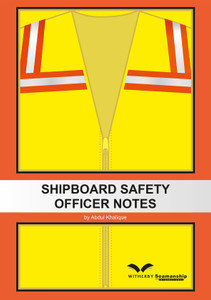
Ship Agency. A Guide to Tramp Ship Agency Practice
This guide to tramp shipping covers, among other topics, the law of agency, duties and liabilities of the agent to the principal, how to select a tramp ship agent and the scope of services provided. The function of the tramp ship agent is explained in detail.
This
book
both
equips
readers
with
a
basic
knowledge
of
tramp
shipping
agents
and
encourages
those
entering
the
industry
to
pursue
further
education.
Various
types
of
employment
for
tramp
ships,
such
as
demise,
bareboat
and
voyage
charter,
are
explained
in
the
context
of
ship
owner
control.
In
the
legal
chapters,
possible
termination
of
agency
relationships
is
explained
in
terms
of
the
operation
of
new
local
laws,
a
breach
in
the
diplomatic
relationship
between
countries
and
the
agent
or
principal’s
change
in
circumstances.
The
book
ends
with
authors’
insight
into
tramp
shipping
agencies.
Except
for
the
pilot,
the
first
and
last
person
to
board
or
depart
during
every
ship’s
port
call
is
the
ship’s
agent.
In
tramp
shipping,
both
in
dry
bulk
and
tanker,
the
selection
of
the
port
agent
at
the
load
and
discharge
port
is
part
of
charter
party
negotiations.
The
shipping
industry
is
a
vast
and
complicated
business.
Due
to
the
many
types
of
ships,
and
the
charter
parties
by
which
they
are
contracted,
the
training
of
boarding
agents
or
water
clerks
can
be
a
long
and
complex
process.
Hopefully,
this
book
will
make
the
process
easier.
It
will
also
provide
ship
owners
and
charterers
with
an
understanding
of
the
function
of
the
ship
agent.
This
book
will
introduce
a
basic
knowledge
of
the
industry
and
encourage
people
entering
shipping
to
further
their
education.
The
first
few
chapters
cover
basic
marine
transportation.
The
middle
chapters
provide
insight
into
the
legal
relationships
between
the
agent,
the
principal
and
third
parties.
The
final
chapters
are
gleaned
from
the
authors’
experiences
of
working
from
the
bottom
up.
Each of the three authors has worked in shipping for over thirty years. They have contributed to this book their background in port agency operations, ship brokerage and maritime law.
Chapter 1 Tramp Ship Agency and the International Shipping Industry
1.1 Definition of ‘Agency’
1.2 The Shipping Industry as a Service
1.3 The Liner Business of Shipping
1.4 The Tramp Ship Owner
Chapter 2 Tramp Shipping
2.1 Tramp Ship Owners and Operators
2.2 Dry Bulk Carriers
2.3 Liquid Bulk Carriers
2.4 Tramp Vessel Operations and Management
2.5 The Commercial Operating of Ships
2.6 Types of Employment for Tramp Vessels
2.7 The Freight Market
Chapter 3 Shipbroking
3.1 Types of Shipbrokers
3.2 The Freight Market
Chapter 4 Tramp Ship Agency Practice
4.1 Port Agency Companies
4.2 Tramp Agency Operation
4.3 Pre-arrival
4.4 The Port Call
4.5 After Sailing Service
4.6 Functions of Agency Staff Members
Chapter 5 Defining Tramp Agency and the Scope of Services Provided
5.1 General Agent
5.2 Special Agent
5.3 The Right to Select the Port Agent
5.4 Charterer’s Nominated Agents
5.5 Hub Agent
5.6 Other Outsource Agency Services
Chapter 6 The Law of Agency
6.1 The Relationship of Agency
6.2 The Creation of Agency
6.3 Agency by Necessity
6.4 Ratification by Principals
6.5 Termination of the Agency Relationship
Chapter 7 The Ship’s Agent, Principals and Third Parties
7.1 The Disclosed Principal
7.2 The Partly-Disclosed Principal
7.3 The Undisclosed Principal
7.4 Third Party Rights Against Agent and Principal in the United Kingdom
7.5 Third Party Rights Against Agent and Principal in the United States
7.6 The Weakness of the ‘As Agent’ Signature
7.7 Creation of a Maritime Lien in the United States
7.8 Ship Agent’s Right to a Lien
Chapter 8 Duties and Liabilities of the Agent to the Principal
8.1 Duty to Act within the Scope of Authority
8.2 The Agent’s Duty of Confidentiality and Loyalty
8.3 Duty and Liability to Contract on the Principal’s Behalf
8.4 The Importance of Contract Signature
8.5 The Duty to Account for Funds Advanced by the Principal
8.6 The Duty to Exercise Care, Skill and Diligence
8.7 Duty of the Agent to Perform all Duties Personally
8.8 Duty to Keep the Principal Informed
8.9 Notification of Principal Through the Agent
Chapter 9 Principal’s Duties and Liability to the Agent
9.1 The Principal’s Duty to Provide an Opportunity for Work
9.2 The Principal’s Duty of Good Conduct
9.3 The Principal’s Duty to Pay Compensation
9.4 Remedies of an Agent
Chapter 10 Indemnity Insurance for Agents
10.1 Protection Coverage for Ship Agents
10.2 When Agents are most Vulnerable to Claims
Chapter 11 Duties under a Time Charter or as a Voyage Charterer’s Nominated Agent
11.1 Voyage Charterer’s Nominated Agent
11.2 Ship Agent’s Duty Under Time Charter
11.3 Disbursements Under Time Charter
11.4 Attendance of Delivery and Redelivery
Chapter 12 How to Select a Tramp Ship Agent
12.1 The Agent is a Reflection of the Party who Nominates or Appoints
12.2 Financial Strength
12.3 The Reporting of Voyage Accounting
12.4 Communication and Cargo Documentation
12.5 Company and Agency Staff Experience
12.6 Worldwide Ship Agency Networks
Chapter 13 Maintenance of the Agent/Principal Relationship
13.1
The
Personal
Relationship
and
Corporate
Relationship
13.2
The
Trade
Relationship
Chapter 14 Charterer’s Liability for Actions of a Nominated Agent
14.1 The Charter Party Agency Clause
14.2 The Incentive for a Voyage Charterer to Nominate the Port Agent
14.3 The Charterer must Make a Reasonable Appointment
14.4 Liability for the Insolvency of the Agent
14.5 Charterer’s Liability Through the Implied Agency Doctrine
14.6 Charterer’s Liability in Cases Where the Nominated Agent is Acting
for a Limited Purpose
14.7 The Ship Owner’s Ratification of the Charterer’s Agency Nomination
Chapter 15 Managing a Tramp Ship Agency
15.1 Tramp Agency Fees
15.2 Service Fees
15.3 Accounting
15.4 Communications
15.5 Staffing
Chapter 16 Tramp Ship Agency Marketing
16.1 Selling to an Owner
16.2 Selling to a Charterer
16.3 Planning a Sales Call
Chapter 17 The Tramp Ship Agency Career
Chapter
18
Authors’
Thoughts
Marygrace Collins
Marygrace was the first woman to serve as President of the Association of Ship Brokers and Agents (USA) Inc, in 2004 and 2005. She remains active in ASBA (the Association of Ship Brokers and Agents) and is the current Vice President of Bulklore Chartering, Inc. She also serves on the Executive Committee of FONASBA and was elected President in October 2012.
Kenneth
Schiels
Kenneth
Schiels
has
held
roles
as
a
boarding
agent,
a
port
manager
and
later
an
executive
for
a
national
ship
agency
in
the
USA.
He
is
the
owner
of
a
marketing
firm
providing
sales
representation
for
international
shipping
agency
firms
in
North
America.
He
is
on
the
Education
Committee
and
the
Agency
Affairs
Committee
for
ASBA
(USA)
Inc.
Peter Skoufalos
Peter Skoufalos is a graduate of New York University and the Boston University School of Law. In his role as partner in the New York firm, Brown, Gavalas & Fromm, he specialises in the areas of commercial and maritime law. Peter has authored several articles on maritime law and is currently Vice Chairman of the US Maritime Law Association Sub Committee on Arbitration and Mediation.
Witherbys
Witherbys
titles
are
developed
using
scripts
developed
by
technical
experts
that
are
peer
reviewed
within
work
groups.
Typically,
they
seek
to
improve
understanding
of
the
regulations,
recommendations
and
guidelines
issued
by
Industry.
Witherbys staff have significant expertise in the fields of navigation and hazardous cargoes as well as in the presentation of complex subjects in a graphic and easy to understand manner.
- Number of Pages:
- 134
- ISBN:
- 9781856095853
- Binding Format:
- Paperback
- Book Height:
- 295 mm
- Book Width:
- 210 mm
- Weight:
- 0.4 kg
- Author:
Marygrace Collins, Kenneth Schiels and Peter Skoufalos
- Published Date:
- July 2013
- Publication Date:
- September 2013




